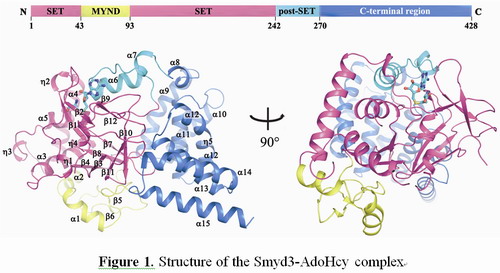Structural and biochemical studies reveal unique features of the cancer-related human lysine methyltransferase Smyd3 and structural basis of its HKMT activity
Source:
Time: 2011-02-10
A team of researchers, led by DING Jianping at the Institute of Biochemistry and Cell Biology, Shanghai Institutes for Biological Sciences, CAS, revealed the unique features of the cancer-related lysine methyltransferase Smyd3 and the structural basis of its HKMT activity.
The SET- and MYND-domain containing (Smyd) proteins constitute a special subfamily of the SET-containing lysine methyltransferases. One of the members, namely Smyd3, specifically catalyzes the methylation of Lys4 of histone H3 (H3K4) and Lys831 of VEGFR1, and has been associated with the pathogenesis of hepatocellular carcinoma and colorectal carcinoma. XU Shutong and colleagues presented the crystal structure of full-length human Smyd3 in complex with S-adenosyl-L-homocysteine at 2.8 Å resolution(Figure 1). Smyd3 affords the first example that other region(s) besides the SET domain and its flanking regions participate in the formation of the active site. Structural analysis showed that the previously uncharacterized C-terminal domain of Smyd3 contains a tetratrico-peptide repeat (TPR) domain which together with the SET and post-SET domains forms a deep, narrow substrate binding pocket. The data demonstrated the important role of both TPR and post-SET domains in the histone lysine methyltransferase (HKMT) activity of Smyd3, and showed that the hydroxyl group of Tyr239 is critical for the enzymatic activity. The characteristic MYND domain is located nearby the substrate binding pocket and exhibits a largely positive-charged surface. Further biochemical assays showed that DNA binding of Smyd3 can stimulate its HKMT activity and the process may be mediated via the MYND domain through direct DNA binding. Together, the results revealed the unique features of Smyd3 compared with the other SET methyltransferases, and provided insights into the structural basis and regulatory mechanism of the HKMT activity of Smyd3.
This work entitled "Structural and biochemical studies of human lysine methyltransferase Smyd3 reveal the important functional roles of its post-SET and TPR domains and the regulation of its activity by DNA binding" was published in Nucleic Acids Research on January 25, 2011.
This work was supported by grants from Ministry of Science and Technology of China, National Natural Science Foundation of China, Chinese Academy of Sciences, and the Science and Technology Commission of Shanghai Municipality.(SIBCB)
AUTHOR CONTACT:
DING Jianping
Institute of Biochemistry and Cell Biology, Shanghai Institutes for Biological Sciences, Chinese Academy of Sciences, Shanghai, China.


 Appendix:
Appendix: